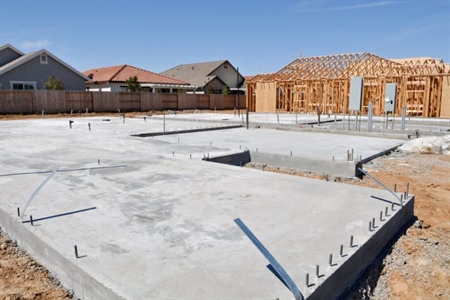What Happens When a Home Doesn’t Have Proper Foundation Grading

The foundation of your home is essential to its healthy life. The foundation is the very first thing built on the property to properly ensure a secure and safe structure for decades to come. However, when the grading of your home’s foundation is off, it can pose a whole mess of problems.
Let’s learn about foundation grading and its effects on your home!
What Does Grading Mean?
The term “grading” when speaking in terms of construction means “slope” or “angle.”
When building a home, you generally want your slope angled away from your home so that rainwater and other moisture will stay away from the foundation.
It’s a simple process to tell if your home has proper grading or not. The next time it rains, or the snow begins to melt, and you see water pooling in places near your house’s foundation, it most likely means the grading near your home is wrong or non-existent.
Problems as a Result of Improper Grading
Improper grading may seem like a small problem, but over time, it can cause major structural damage to your home. For instance, if your home’s roof fails to have proper grading, it can allow rainwater or snowmelt to seep into the interior of your home, causing damage to interior parts of your home, like mold buildup or electrical wiring damage.
When it comes to improper grading around your home’s foundation, it tends to pose a more serious and expensive problem. Much like your roof, water damage can occur if the grading around your foundation is inadequate. Plus, the foundation issues caused by improper grading are less obvious and may fail a home inspection.
Water Damage
When water pools around your foundation, it will begin to seep into the ground and make its way through the cinder blocks and bricks. Over time, the water will begin to wear down the foundation causing massive cracks and chips, weakening its integrity and strength.
Foundation Shifts
Another side-effect of water damage to your foundation is shifting or sinking. Your home's foundation is meant to be square and level. When water damage causes shifting or sinking, the whole house moves unevenly, which can damage just about any part of your home.
You can tell your home has foundation damage by checking for any cracks or dents in the foundation or even on the walls inside your home, as it will indicate a point of stress during the shift.
Mold and Mildew Growth
Moisture can accumulate around the foundation and in the basement or crawl space, which creates an ideal environment for mold and mildew growth. Mold can spread quickly and pose health risks to your family, such as respiratory issues, allergies, and other health problems.
Erosion
Improper grading can also lead to soil erosion, particularly during heavy rainstorms or flooding. As water flows toward the foundation, it can wash away soil and landscaping materials, which creates voids, sinkholes, or uneven ground surfaces.
Pest Infestations
Standing water and moisture also attract pests such as mosquitos, termites, ants, and rodents. These pests can infiltrate your home, cause damage to the structure, and pose health risks.
Drainage Issues
Improper grading can interfere with the functionality of drainage systems, such as gutters, downspouts, and French drains. Water may not flow away from the home, which can lead to clogs, backups, and overflows.
Inspect Your Foundation With DMC Home Inspections
With over 150 points of thorough inspection and being InterNACHI and ASHI home certified, DMC Home Inspections is the most trusted in the Twin Cities for foundation inspections and other inspections such as plumbing, sewer, as well as pre-inspections.
Schedule an Inspection online or give us a call at 612-310-1692 today!